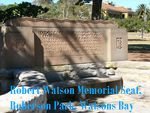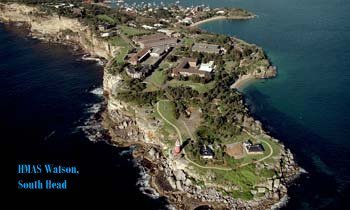Robert Watson
was born in Northumberland northern England in
about 1766 (First Fleet record), though his birth
could have been as early as 1756 (according to his
age shown on his death certificate). He joined the
H.M.S. Sirius on 20th December 1786 as an
able seaman. As yet little is known about his
earlier life.
He set sail
as a crew member and sail maker aboard the H.M.S.
Sirius, the flagship of the First Fleet, from
Portsmouth England in May 1787. During the voyage
he was promoted to Quartermaster. The ship was
under the command of Captain John HUNTER, the
2nd Lieutenant RN was Philip Gidley KING and
it also carried Captain Arthur PHILLIP.
These 3 officers were later to become the first 3
governors of the new colony. The fleet arrived in
Botany Bay on 21st January 1788 after 252 days at
sea. Robert Watson is reputed to have been one of
the first to have set foot on Australian soil
(ref:
Royal Navy Settlers website).
Robert Watson
left Port Jackson on board the H.M.S. Sirius
on 2nd October 1788. They sailed back to the Cape
of Good Hope to get much needed flour and other
supplies. The arduous voyage took more than seven
months to complete and returned just in time to save
the near-starving colony.
The Sirius
was to act as a re-supply vessel and communications
link between New South Wales, Norfolk Island and
England. After reaching Norfolk Island and
successfully unloading the marines and convicts on
13th & 15th March1790 in Cascade Bay, tragically, on
19th March 1790, the ship was wrecked on a reef at
Sydney Bay, Norfolk Island whilst trying to land
provisions. The Sirius’s crew would be stranded for
a year on Norfolk Island.
Robert Watson
most likely had a common law marriage (as no
marriage record has been found) with Sarah
Dorsett one of the many convict women aboard the
Lady Juliana (also commonly referred to as
The Floating Brothel). Sarah had been convicted of
stealing a man’s coat and is frequently mentioned in
Sian Rees’s novel “The Floating Brothel” and also
the autobiography of John Nicol, which was
published in 1822. The Lady Juliana left
Plymouth on 29th July 1789 and arrived in Port
Jackson 309 days later on 6th June 1790, one of the
slowest journeys made by a convict ship. The
Lady Juliana was the first convict ship to
arrive in Port Jackson after the arrival of the 1st
fleet. Three weeks after the arrival of the Lady
Juliana, the ships of the infamous 2nd Fleet
arrived. Sarah Dorsett was later sent to the penal
colony on Norfolk Island and arrived there in August
1790. She was accompanied by her infant son
Edward Dorsett Powell who had been born at sea
near Rio de Janeiro and whose father was a sailor
on the Lady Juliana
by the name of Edward Powell.
Robert Watson
left Norfolk Island on 21st February 1791 aboard the
ship Supply with Captain John Hunter and crew
members of the Sirius. Robert remained in Port
Jackson whilst Captain Hunter and some of the crew
continued on to England. He then returned to
Norfolk Island in May 1791 to become a free
settler. He received a 60 acre grant at Cascade Run
and was selling provisions to the government by May
1792.
In 1792 his
daughter Rebecca was born. He also had a son John
(possibly born in Sydney). He eventually sold his
farm in 1793 when he became mate of the schooner
'Francis'.
In 1800 Robert
was placed in charge of the Dawes Point battery on
the east point of the western side of Sydney Cove.
In 1801 he was also appointed Boatswain of the
dockyard which was also located on the western side
of Sydney Cove. Governor King granted him
land in 1801 at South Head, later to become known as
Watson’s Bay.
At some stage
between 1794 and the 1806 muster, Sarah had left
Robert and her 3 children and she was listed as
living with John Woodward (later they had 4
children together).
In April 1811
soon after the South Head Road was completed,
Governor Macquarie visited Robert Watson at the
new stone house and outbuildings he had built and
the Governor granted him a free licence to sell
spirits there. On 17th August 1811 after this visit
Governor Macquarie also appointed him Harbour Master
and Senior Pilot of Port Jackson.
In January to
March 1814 he was piloting the 'Kangaroo'
during the evacuation of Norfolk Island. Soon
afterwards he resigned from his post of pilot, but
retained the appointments of Harbour Master and
Boatswain of the dockyard. His son-in-law Robert
Murray was appointed Pilot in place of Robert
Watson.
In November
1816 he was dismissed from his appointments on a
charge of stealing canvas. He was subsequently
sentenced to 3years in HM gaol at Parramatta but
only served 2 weeks; Governor Macquarie granted him
a Conditional and Absolute pardon for “In
consideration of the former good character of the
said Robert Watson, and of his long and faithful
service in this colony”
(State Records of NSW Colonial Secretary Index,
1788-1825)
In November 1818,
the Macquarie Lighthouse was completed and Robert
was installed as its first Lighthouse-Keeper on the
same salary that he had received as Harbour Master.
At the end of
October 1819, he requested temporary leave because
of illness and died at his house in The Rocks,
Sydney, on 1 November 1819 after 31 years in the
colony.
 His
funeral service was held at St Philips Church and he
was buried in the Sandhills Cemetery (present day
site of Central Railway). Both Robert’s and
Edward’s remains were removed in 1901 to the
Bunnerong Cemetery (Botany).
His
funeral service was held at St Philips Church and he
was buried in the Sandhills Cemetery (present day
site of Central Railway). Both Robert’s and
Edward’s remains were removed in 1901 to the
Bunnerong Cemetery (Botany).
The above are
just a few of the many incidents, positions held &
services performed by Robert Watson since his
arrival in the colony.
Following are
places in Sydney named after Robert Watson:
Observatory Hill
in Sydney is in Watson Road (possibly named after
Robert).
HMAS Watson which
is located at South Head is also named after Robert
Watson,
(WWW.navy.gov.au/establishments/hmas-Watson)
 In
1929 a stone seat bearing the following inscription
was erected in Robertson Park, Watson's Bay:
In
1929 a stone seat bearing the following inscription
was erected in Robertson Park, Watson's Bay:
"To commemorate
Robert Watson after whom this Bay is named.
Quartermaster of H.M.S.Sirius 1786-1790
Signal -Man South Head 1791-1811 Pilot and Harbour
Master 1811-1816 Superintendent of Macquarie
Lighthouse 1818 Died 1st November 1819'.
His Children, His legacy.
His adopted son
Edward (Dorsett Powell) Watson followed in
his father’s footsteps and became Master of the
Estramina, the Lady Nelson and the
Hawkesbury Packet. Edward died on the 19th
February 1820 aged 31 years and was buried with
Robert Watson who he considered to be his father.
Edward had one known son named Edward Watson Jnr.
Little is known
at the moment about Robert’s other son (his only
known biological son), John Watson, who also
followed in his father’s footsteps and became a
mariner. On 26 October 1821, along with his sister,
petitioned the Governor to be granted their father’s
land at South Head.
Rebecca Watson
(my 4th Great Grandmother), married Robert Murray
a Port Jackson Harbour Pilot (who tragically
drowned on 30 January 1822). She was pregnant with
her daughter Sarah Rebecca Murray when he
died. She had lost her father, her brother Edward &
her husband within the space of 2 years. Tragically
she turned to alcohol and died on 28 Sep 1826,
leaving her daughter an orphan.
As Colleen
McCulloch wrote in her book Morgan’s Run:
“How much of
England has England wasted! The intelligence, the
ingenuity, the resourcefulness, the hardiness. And
all of the owners had sat in English gaols and hulks
utterly wasted. What is wrong with England, that
England is blind enough to throw such assets away as
worthless rubbish” I say thank God for England’s
stupidity.
I would like to
dedicate this story to my nanna Olive Jackson for
starting me on this road of discovery and also to my
grandpa Herbert Jackson (one of the brave “Rats of
Tobruk”) for being a descendant of so many convicts
(8 so far) & free men who helped shape this great
country.
 I
would also like to dedicate this article to Robert
Watson for having the courage and foresight to
venture to and stay in this foreign land and make so
many valuable contributions to the new colony.
I
would also like to dedicate this article to Robert
Watson for having the courage and foresight to
venture to and stay in this foreign land and make so
many valuable contributions to the new colony.
Suzanne Kirby
with editorial help from Doug Kirby
In May 2016 a memorial plaque to Robert Watson Able
seaman "HMS Sirius" was installed in the
First Fleet Memorial Park in the Eastern Suburbs
Memorial Park
Bibliography
M Jeavons for
sharing with me information she had collected
Amanda Taylor on
Roots web
Joy Murrin Family
History Services – Transcription Services
Australian
Dictionary of Biography, National Centre of
Biography, Australian National University, E. J.
Lea-Scarlett
F. J. Bayldon,
‘History of the Pilotage Service of Port Jackson’,
Journal and Proceedings (Royal Australian Historical
Society), vol 20, part 3, 1934, pp 129-63
Sydney Gazette, 5
Oct, 2 Nov 1816, 6 Nov 1819
State Library of New
South Wales
Royal Australian
Historical Society Library, Sydney
Wikipedia – HMS
Sirius, Lady Juliana, John Nicol, - First Fleet
Fellowship Victoria
“The Founders of
Australia” a Biographical Dictionary of the First
Fleet written by Mollie GILLEN
Australian Navy
website, Royal Navy settlers, Roots web
Hobart Town Gazette
National Archives,
London
Ancestry & Genealogy
records
State Records of NSW
Colonial Secretary Index, 1788-1825
List of convict ancestors for Herbert
Jackson
Sarah
Dorsett – 2nd
Fleet – arrival June 1790 - Lady Juliana
Mary
Ann Harrison –2nd
or 3rd
Fleet – arrival July 1791 – Mary Ann
Edward Robinson – 3rd
Fleet – arrival Oct - 1791 – Admiral Barrington
William Henry –
arrival June 1801 – Earl Cornwallis
Jane Carr – arrival
June 1801 – Earl Cornwallis
George Smith -
arrival Jan 1806 - Fortune
Thomas Fuller –
arrival Nov 1817 – Larkins
Richard Jackson –
arrival March 1833 - Andromeda
